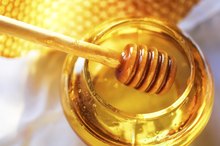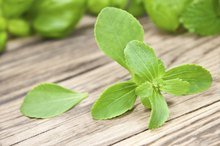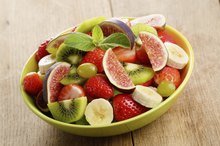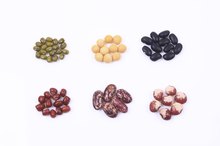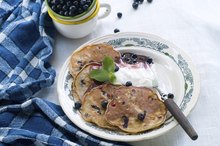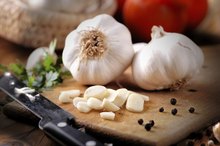Nuts & Dried Fruit Snacks for a No-Starch Diet
Starchy foods have a high carbohydrate content, and most Americans eat them on a daily basis 1. For example, starch is found in breakfast cereals, oatmeal, croissants, toasts and muffins at breakfast; your sub sandwich, panini, pizza dough, french fries or rice at lunch; and your mashed potatoes, pasta, tortillas, buns or corn at dinner. Many snack foods also have a high starch content, including crackers, granola bars, pretzels, rice cakes and muffins. If you are eliminating starches from your diet, nuts and dried fruits are satisfying and nutritious snack options.
No-Starch Diet
Going on a no-starch diet is an effective yet simple way to restrict your carb intake, and a lower carb intake can help you lose weight, decrease your triglycerides and improve your HDL cholesterol levels, according to the May 2004 issue of "Annals of Internal Medicine." However, carbohydrates do not only include starches, they also comprise sugars and fibers. It is a good idea to also limit added sugar, sweeteners and candies on your no-starch diet because these foods only provide empty calories, but you can get a moderate amount of carbohydrates from fruits, plain yogurt and milk if desired.
Nuts and Dried Fruits
Low-Starch Diets
Learn More
Nuts and dried fruits are free of starch and can be included in your no-starch diet. Nuts contain protein, which is the most satiating nutrient, and healthy monounsaturated fats, which are good to promote heart health 1. An ounce of nuts contains about 163 to 204 calories, 2.2 to 6.7 g of protein, 14.0 to 21.5 g of fat, 3.9 to 6.1 g of carbs and 1.9 to 3.5 g of fiber. Dried fruits are low in fat and protein, but rich in carbohydrates, with about 70 to 93 calories, 18.6 to 25.0 g of carbohydrates and 1.7 to 2.3 g of fiber per 2 to 4 tbsp., depending on the variety.
- Nuts and dried fruits are free of starch and can be included in your no-starch diet.
- Dried fruits are low in fat and protein, but rich in carbohydrates, with about 70 to 93 calories, 18.6 to 25.0 g of carbohydrates and 1.7 to 2.3 g of fiber per 2 to 4 tbsp.,
Make Smart Choices
When choosing nuts, opt for plain or dry-roasted nuts. Avoid the ones that are coated with sugar or seasoned with salt or other salty seasonings. Read the ingredient list to ensure no fat, especially no trans fat like shortening or hydrogenated oils, has been added. With dried fruits, choose unsweetened dried fruits. Dried fruits are naturally sweet because they naturally contain natural sugars 1. Added sugar contributes to increasing your calorie and sugar intake and may hinder your weight loss.
- When choosing nuts, opt for plain or dry-roasted nuts.
- Read the ingredient list to ensure no fat, especially no trans fat like shortening or hydrogenated oils, has been added.
Examples of Combinations
Can Salted Peanuts Make My Blood Sugar Rise?
Learn More
Make your own trail mixes by combining different nuts and dried fruits. For example, you could have a tropical mix with macadamia nuts, a bit of unsweetened dried coconut flakes, dried mango, dried papaya and dried banana. Put the mixture in a plastic bag or container and bring it to work or carry it in your gym bag in case you need a snack. You can also mix almonds with dried cranberries, walnuts with dried apples and a touch of cinnamon and nutmeg, peanuts and raisins, or put all the different nuts and dried fruits you have on hand for a surprise mix.
- Make your own trail mixes by combining different nuts and dried fruits.
- You can also mix almonds with dried cranberries, walnuts with dried apples and a touch of cinnamon and nutmeg, peanuts and raisins, or put all the different nuts and dried fruits you have on hand for a surprise mix.
Related Articles
References
- USDA National Nutrient Database: Nutrient Data Laboratory
- United States Department of Agriculture Agricultural Research Service National Nutrient Database for Standard Reference Release 28.
Writer Bio
Aglaee Jacob is a registered dietitian. She has experience working with people who have diabetes, cardiovascular disease, hypertension and obesity issues. Jacob obtained a bachelor of science and a master of science, both in nutrition, from Laval University in Quebec City, Canada.



